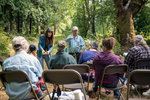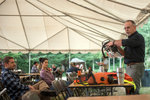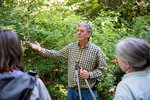


OAKVILLE — To an outside observer, the task of growing a forest of trees likely doesn’t seem too difficult. Find some open land. Plant some trees. Sit back and laugh until the sound of ripping chain saws rings in the profits.
According to Andy Perleberg, Washington State University Extension forester, that’s not entirely correct, even in the verdant landscape of Western Washington.
“I would say that the majority of family forests are in it for the lifestyle rather than the profit,” said Perleberg during a family forestry workshop at Wild Thyme Farm in Oakville last Saturday. “This family forestry stuff isn’t rocket science. It’s harder because of all the uncertainty.”
Those uncertainties include what types of trees to plant and what sorts of microbes and nutrients, or even diseases, are held in the soil. Will there be drought? Will there be a flood? Will a wildfire rip through the forest before it can be harvested? Will there even be a market for timber once it’s time to cut the decades old trees?
As a professional forester, Perleberg understands those uncertainties and he has made it his mission to help educate forest owners and prospective forest owners on the cache of resources near at hand that will help to navigate the dark woods of independent sylviculture.
The family forestry event outside of Oakville last Saturday drew roughly 250 people, which Pereleberg said is about normal for such a remote event in a location halfway to the famously far out Brooklyn Tavern. He says that similar events held in Maytown and Yelm can sometimes bring in as many as 600 people per day.
“If I can reach 100 families in a place like this than I’ll feel like it’s well worth it,” said Perleberg.
Julie Sacketts, a forester with the Department of Natural Resources who taught multiple classes among the understory of the forest on Saturday, said she has seen an increased commitment to the principles of responsible and effective forest management in recent years.
“I think people are understanding that they don’t have to manage their forest like an industrial forest,” said Sacketts. “The forest stewardship approach is really listening to the landowner, talking about what they want and then we try to help them achieve that.”
One of the workshops that Sacketts taught on Saturday was related to plant, tree and shrub identification. She taught that class with the help of Ken Bevis, another forester from the DNR, who believes that having a thorough understanding of the plants in a person’s forest is the first step toward healthy, active management.
“I think it’s really important for us to be the experts of our own land because we are responsible for that little slice of the Earth,” explained Bevis, who sees value in both dead and living organisms within the forest ecosystem. “I’m an Evangelical Snaggist. … I am constantly extolling the virtue of standing dead timber.”
Another presenter with an eye toward both the canopy and the forest floor on Saturday was Jim Freed, a retired WSU Extension forester and current volunteer educator. Freed delivered a talk on identifying and managing wild edibles within a forest and noted that the most important component is proper management of sunlight to the understory. At one point he pointed out a stunted filbert tree that should have been producing nuts but instead stood wispy and fruitless due to its station at the bottom of a dense thicket of tall timbers.
“See, this is what happens to a fruit-bearing tree that is deprived of sunshine,” noted Freed. “It takes sunshine to make sugar.”
Freed also noted that depending on the effect a forester is intending to inflict on a particular section of forest, leaving the canopy or overstory of the forest may be the best practice afterall. For instance, if a dependable patch of edible mushrooms always sprouts from the same spot each year it is wise not to mess with the trees and shrubs nearby that have helped to create such a suitable environment for fruiting fungi.
Freed noted that an intact forest canopy can create conditions that are 15-20 degrees cooler than surrounding areas during the summer. Similarly, those well shrouded areas can stay 10-15 degrees warmer in the winter while remaining relatively dry due to the natural drip line of the trees.
Perleberg says that a common question he receives from farmers and foresters in Southwest Washington is how to manage overgrown Christmas tree lots that have outgrown their marketability. Perleberg says that the WSU Extension office has created an entire protocol for how to transform an overgrown Christmas tree plantation into a working forest that will one day be ready for profitable harvest.
“Basically you’re managing for density,” explained Perleberg. “Anytime trees limbs are touching each other they are competing with each other for the goodies.”
However, Perleberg said that selling trees is typically a secondary concern for folks looking to curate a healthy forest on their property. After all, the lifespan of healthy trees means that most trees will not be harvested by the same people who planted them.
“There are things that all forest owners have in common. The first is that they all want a healthy forest. The other is that they all love tools. There is no imaginary average forest owner. People own land for all types of reasons” said Perleberg. “These are the people that are ready to commit to the long term benefit of forest lands for the owner and for society and they are quite aware that everything they do impacts those around them.”
Perleberg listed clean water, clean air and healthy wildlife among the benefits of a healthy forest landscape.
On a recent trip to Ocean Shores from Oakville, Perleberg was accompanied by his young son. As they made their way through the rolling timber country they watched plots of all types roll by. There were recent clear-cut stump fields and overgrown tickets. There were blackberry brambles choking underbrush and climbing trunks. There were signs of overharvesting in places and then there were other lots that looked as though they hadn’t been touched in decades. As they took stock of all the different wood lots Perleberg said his son asked him which of the plots were the good ones.
“All of this is good because it’s not asphalt,” said Perleberg.
Additional information on family forestry practices can be found on the DNR website at http://www.dnr.wa.gov/ or by calling your local WSU Extension office and asking to speak with a forester.